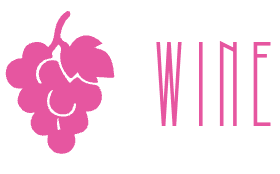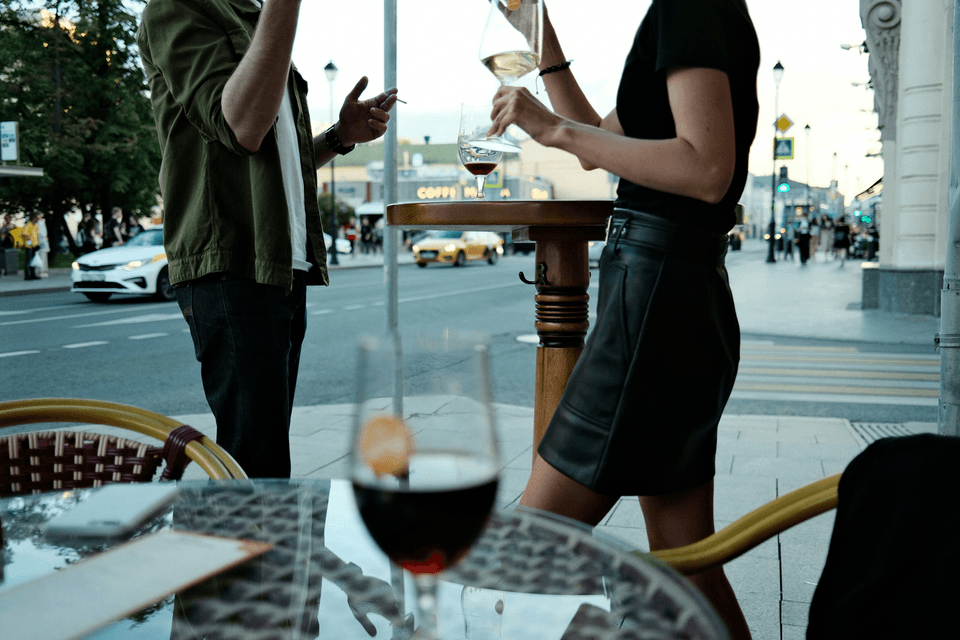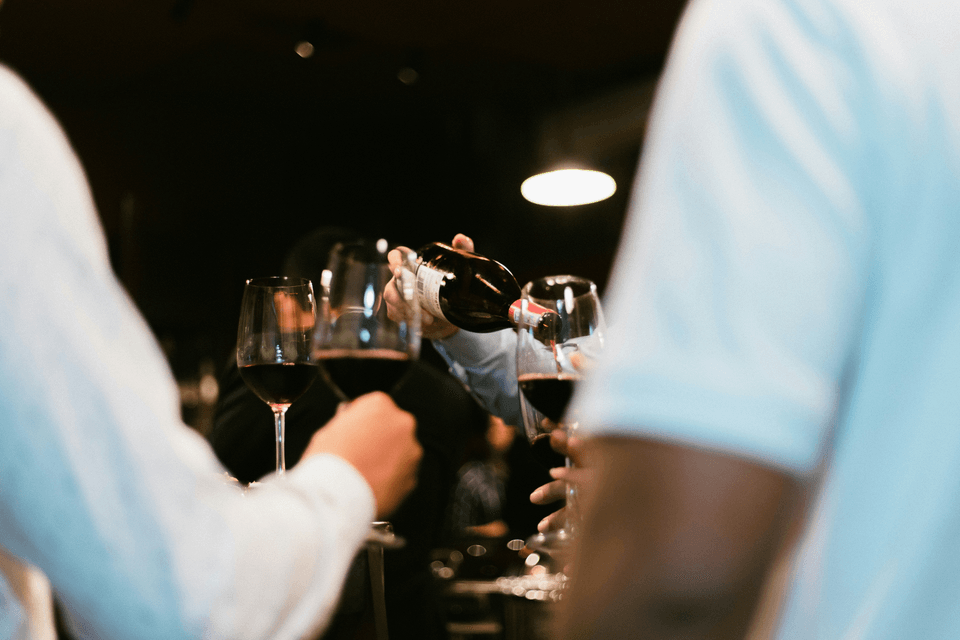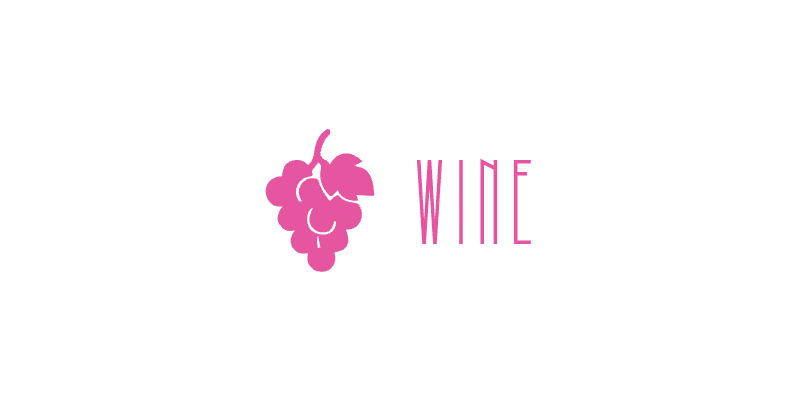
Wine Label Information
Labels play an important role in the wine world. Beyond the obvious function of attracting attention and distinguishing a wine from its competitors, they also provide vital product information and are a basic legal requirement. Understanding wine labels is not always easy. While some countries keep their labels relatively simple and straightforward, others have complex and highly communicative wine labeling traditions
Navigating a wine label
This example comes from Austria.
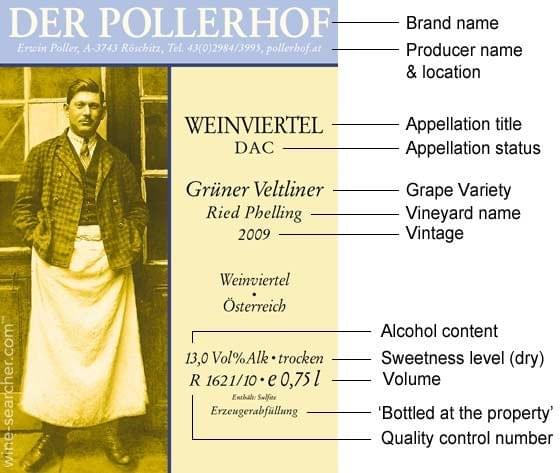
Wine Labeling Laws
Each wine-producing country has its own laws about what must (and what must not) appear on its wine labels, and on those of imported wines. The most obvious information on a typical wine label is its producer or brand name, region of origin, vintage, and often the grape variety or blend the wine is made from. Beyond that, almost every country requires labels to state the producer's location, the bottle's volume, the wine's alcohol content and whether it contains allergens (particularly sulfites).
Wine Label Vocabulary
Wine labels tread a fine line between marketing needs and legal requirements; they must be attractive, communicative and compliant all at the same time. To ensure some level of consistency, the wine world uses a well-developed set of concepts, terms and phrases for its labels.
Most wine labeling terms are officially defined and carefully controlled. These relate to simple ideas, such as grape variety names, but also to very complex concepts such as the prädikat system (see German Wine Labels).
Wine lawmakers go to great lengths to distinguish between similar-sounding words, with the goal of keeping consumers informed about what kind of wine is inside the bottle (although how successful they are is a matter of much debate). There is a small but significant difference, for example, between Barossa and Barossa Valley, and a big difference between Montepulciano (a grape variety) and Vino Nobile di Montepulciano (a wine from the town of Montepulciano in Tuscany).
Some wine labeling terms are not legally defined, however. 'Old Vines' and its French form Vieilles Vignes, for example, have no legal definition. Their meaning relies entirely on traditional usage, and is regulated only by market forces (i.e. consumer perceptions). But there is an entire lexicon of terms which are officially, legally defined.
Quality and Classifications
The two most important aspects of any wine-buying decision are price and quality. While prices can be communicated simply and accurately using numbers, reliably indicating quality is far from simple. Consumers often use brand names as a gauge of quality, but this is far from ideal; brand quality can fluctuate significantly over time, and brand-positive perception can be generated by investing in marketing rather than winemaking.
This is why wine law-makers, particularly those in Europe, work so hard to devise ways of objectively distinguishing high-quality wines from low-quality wines (see EU Wine Labels). One of the world's earliest wine classifications focused exclusively on the wines of Bordeaux, ranking their quality as it stood in 1855 (see 1855 Medoc Classification). Seventy-five years later, France introduced its nationwide appellation contrôlée classification system, on which other European countries have modeled their wine laws.
Regions, Appellations, Indications and Designations
A wine's origin is a key part of its identity, as it implies something about its style and likely quality. Many thousands of official place names are used on the world's wine labels. Some of these indicate only the wine's origin, while others combine origin, style and quality all into one.
Examples of the first include the United States' AVA (American Viticultural Area), Australia's GI (Geographical Indication) and South Africa's WO (Wine of Origin).
Examples of the second are found mostly in Europe, and are most famously exemplified by France's Appellation d'Origine Contrôlée (AOC), which provided the model for Italy's Denominazione di Origine Controllata (DOC), Spain's Denominación de Origen (DO) and more recently Austria's Districtus Austriae Controllatus (DAC). There are roughly 300 French AOC titles, each of which communicates not just the geographical origins of its wines, but also their approximate style and quality.
Labeling a wine as 'Bourgogne Rouge', for example, confirms both that it was made in Burgundy and that it is a dry, medium-bodied red made predominantly from Pinot Noir. It also indicates that the wine is of good quality, but is probably not as fine as a Premier Cru or Grand Cru wine.
Varieties and Varietals
Some wines, particularly those in the New World, show their grape variety or blend on the front label, as if part of their name. Under the laws of most wine-producing countries, this means that at least 85 percent of the wine inside is made from the stated variety or varieties.
In response to consumer demand for such varietal labeling, the practice is now increasingly common in Europe, although the majority of French appellations actively forbid the mention of grape varieties on front labels. Spain, Portugal, and particularly Italy, are moving steadily towards varietal labeling and winemaking.
For region-specific wine label information see: United States, European Union, France, Italy, Spain, Germany, Austria and Australia.
Empowering Investors
Our mission is to equip investors with the essential knowledge and resources required to make well-informed decisions within the wine market, thereby helping them reach their financial aspirations. Our team of specialists is dedicated to offering tailored advice and insightful market analysis, allowing you to confidently navigate the intricacies of wine investment.
Exceptional Quality
Our rigorous selection process emphasizes quality, targeting wines that not only deliver exquisite flavors but also possess significant investment potential. We carefully assess each wine's origin, year, and market interest to guarantee that our clients are presented with only the highest-quality selections. Utilizing our broad network and profound industry knowledge, we consistently uncover emerging trends, allowing you to take advantage of profitable opportunities and enhance the growth of your investment portfolio.
Building Trust
Our focus is on cultivating enduring partnerships with our clients, promoting confidence through open communication and exceptional service at every step. We are committed to making you feel appreciated and secure as you navigate your investment path. By emphasizing your priorities and ensuring consistent dialogue, we aim to nurture an atmosphere where your investment objectives can thrive.
Wine Spectator Top 100 Wines
Wine Spectator Magazine has published its Top 100 Wines list every year since 1988. Its influence is substantial; many wines that earn prominent positions in the list sell quickly in following months, often at increased prices.
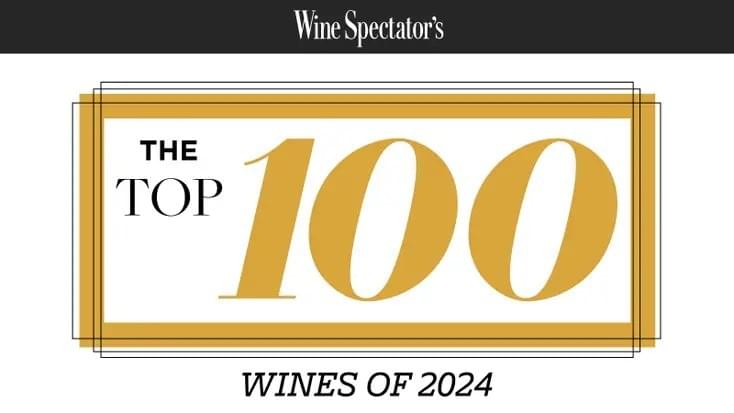
Chile leads the way in 2024
The number one sport is taken by a Chilean wine for only the second time since the list began in 1988 (the first being Clos Apalta in 2008). Don Melchor is a stand-alone flagship of Concha y Toro in Puente Alto, a subregion of the Maipo Valley regarded as the country's finest vineyard zone.
California accounts for half of the top ten, which also features an Oregon Pinot Noir, two Italian classics, and just the one French wine.
Click on the link for the Don Melchor Cabernet Sauvignon, or any other wine in the list below, to check prices and availability.
For wine scores from across the publication's regular output see the Wine Spectator page in our Critics area. See also our list of Robert Parker 100-point wines.
Want to check previous editions of the Wine Spectator Top 100?
1 Concha y Toro Don Melchor Cabernet Sauvignon, Puente Alto # 2021 / 96
2 Beaulieu Vineyard BV Georges de Latour Private Reserve Cabernet Sauvignon, Napa Valley # 2021 / 95
3 Marchesi Antinori Tignanello Toscana IGT, Tuscany # 2021 / 97
4 Faust Cabernet Sauvignon, Napa Valley # 2021 / 94
5 Chimney Rock Cabernet Sauvignon, Stags Leap District # 2021 / 94
6 Roserock Pinot Noir, Eola-Amity Hills # 2022 / 94
7 Domaine du Vieux Telegraphe Chateauneuf-du-Pape La Crau, Rhone # 2020 / 94
8 Williams Selyem 'Eastside Road Neighbors' Pinot Noir, Russian River Valley # 2022 / 95
9 G.D. Vajra Albe, Barolo DOCG # 2020 / 94
10 Ramey Chardonnay, Russian River Valley # 2022 / 94
11 Craggy Range Te Muna Road Vineyard Sauvignon Blanc, Martinborough # 2023 / 94
12 Penfolds Bin 389 Cabernet - Shiraz # 2022 / 94
13 Felsina Berardenga Chianti Classico Riserva DOCG, Tuscany # 2021 / 95
14 Turley Wine Cellars Juvenile Zinfandel, California # 2022 / 93
15 Caprili Brunello di Montalcino DOCG, Tuscany # 2019 / 96
16 Merry Edwards Winery Sauvignon Blanc, Russian River Valley # 2022 / 95
17 Bledsoe Family Winery Cabernet Sauvignon, Walla Walla Valley # 2021 / 94
18 Michele Satta Piastraia Bolgheri Superiore, Tuscany # 2021 / 95
19 La Fiorita Brunello di Montalcino DOCG, Tuscany # 2019 / 95
20 Roederer Estate Brut, Anderson Valley # NV / 93
21 Carlisle Papera Ranch Zinfandel, Russian River Valley # 2021 / 95
22 Siro Pacenti PS Pelagrilli, Brunello di Montalcino DOCG # 2019 / 97
23 Figgins Estate Red, Walla Walla Valley # 2020 / 95
24 San Felice 'Il Grigio da San Felice', Chianti Classico Riserva DOCG # 2021 / 93
25 Rutherford Hill Merlot, Napa Valley # 2021 / 93
26 Dow's Late Bottled Vintage Port # 2018 / 93
27 St. Supery Dollarhide Ranch Sauvignon Blanc, Napa Valley # 2022 / 94
28 Castello Romitorio Brunello di Montalcino DOCG, Tuscany # 2019 / 97
29 Calera Ryan Vineyard Pinot Noir, Mount Harlan # 2021 / 96
30 Kaiken Ultra Malbec, Uco Valley # 2021 / 92
31 Patz & Hall Pinot Noir, Sonoma Coast # 2021 / 93
32 Barnard Griffin Cabernet Sauvignon, Columbia Valley # 2021 / 92
33 Elena Walch Pinot Grigio Alto Adige, Trentino-Alto Adige # 2023 / 91
34 Bergstrom La Spirale Vineyard Pinot Noir, Ribbon Ridge # 2022 / 95
35 Castellare di Castellina 'I Sodi di San Niccolo' Toscana IGT, Tuscany # 2020 / 97
36 VIK 'Milla Cala', Millahue # 2021 / 93
37 Vallepicciola Chianti Classico DOCG, Tuscany # 2021 / 92
38 Racines 'Sta. Rita Hills Cuvee' Pinot Noir, California # 2021 / 94
39 Vina Cobos Cocodrilo Corte, Mendoza # 2022 / 92
40 Wente Vineyards Morning Fog Chardonnay, Livermore Valley # 2022 / 90
41 Whitehaven Sauvignon Blanc, Marlborough # 2023 / 90
42 Viberti Giovanni 'La Gemella' Barbera d'Alba, Piedmont # 2022 / 91
43 Flowers Chardonnay, Sonoma Coast # 2023 / 93
44 Feudo Montoni 'Vigna Lagnusa' Nero d'Avola Sicilia IGT, Sicily # 2022 / 90
45 Chateau du Retout, Haut-Medoc # 2022 / 92
46 Fattoria Le Pupille 'Saffredi' Maremma Toscana, Tuscany # 2021 / 97
47 Bethel Heights Vineyard Pinot Noir, Eola-Amity Hills # 2022 / 92
48 Joseph Drouhin Saint-Veran, Maconnais # 2022 / 91
49 Marchesi Antinori Santa Cristina Cabernet Sauvignon Toscana IGT, Tuscany # 2022 / 90
50 Barone Ricasoli Colledila, Chianti Classico Gran Selezione DOCG # 2021 / 97
51 Bodegas Muga Reserva - Crianza, Rioja DOCa # 2020 / 91
52 Lavinea Pinot Noir, Eola-Amity Hills # 2022 / 94
53 R. Lopez de Heredia Vina Tondonia Reserva, Rioja DOCa # 2011 / 93
54 Kistler 'Cuvee Natalie' Silver Belt Pinot Noir, Sonoma Coast # 2021 / 96
55 Domaine Tempier Bandol Rose, Provence # 2023 / 93
56 Bodegas El Nido 'Clio', Jumilla # 2021 / 92
57 Stag's Leap Wine Cellars Estate 'Cask 23' Cabernet Sauvignon, Napa Valley # 2021 / 97
58 Annulus Vine Hill Ranch Vineyard Cabernet Sauvignon, Oakville # 2023 / 91
59 Isaac Fernandez Seleccion 'Finca La Mata' Tinto, Ribera del Duero # 2022 / 90
60 Umani Ronchi Casal di Serra Verdicchio dei Castelli di Jesi Classico Superiore, Marche # 2022 / 90
61 Weingut St. Urbans-Hof Nik Weis 'From Old Vines' Estate Riesling, Mosel # 2022 / 90
62 Txomin Etxaniz Txakoli, Getariako Txakolina # 2023 / 90
63 Pierre Gimonnet et Fils Blanc de Blancs Cuis Premier Cru Brut, Champagne # NV / 93
64 Mayu Don Mauro Vineyard Gran Reserva Syrah, Elqui Valley # 2021 / 91
65 William Fevre Chablis, Burgundy # 2022 / 92
66 Jose Maria da Fonseca 'Anticiclone', Vinho Regional Peninsula de Setubal # 2022 / 90
67 Royal Tokaji Aszu 5 Puttonyos, Tokaj # 2018 / 93
68 Law Estate Wines 'Beguiling', Paso Robles # 2021 / 94
69 Annulus Vine Hill Ranch Vineyard Cabernet Sauvignon, Oakville # 2022 / 91
70 Cantina Pra 'Otto' Soave Classico, Veneto # 2022 / 90
71 Aperture Cellars Chenin Blanc, Clarksburg # 2023 / 91
72 Massican 'Annia', Napa Valley # 2022 / 91
73 Burgess 'Promiscua' Cabernet Sauvignon, Napa Valley # 2021 / 93
74 Domaine Roy & Fils 'Maison Roy Incline' Pinot Noir, Oregon # 2022 / 94
75 Sullivan Estate Coeur de Vigne Cabernet Sauvignon, Rutherford # 2021 / 94
76 Annulus Vine Hill Ranch Vineyard Cabernet Sauvignon, Oakville # 2022 / 90
77 Klein Constantia Chardonnay, Constantia # 2022 / 90
78 Annulus Vine Hill Ranch Vineyard Cabernet Sauvignon, Oakville # 2020 / 90
79 Domaine de la Janasse Cuvee Vieilles Vignes, Chateauneuf-du-Pape # 2022 / 95
80 Henri Bourgeois Sancerre ES-56, Loire # 2022 / 92
81 Soalheiro Alvarinho, Vinho Verde # 2023 / 90
82 Invivo X SJP Sarah Jessica Parker Pinot Noir, Marlborough # 2022 / 90
83 Denis Dubourdieu Chateau Doisy-Daene Grand Vin Sec, Bordeaux # 2022 / 93
84 Burn Cottage Moonlight Race Pinot Noir, Central Otago # 2022 / 95
85 Montenidoli Tradizionale, Vernaccia di San Gimignano DOCG # 2022 / 90
86 Gorman Winery The Evil Twin Syrah - Cabernet Sauvignon, Red Mountain # 2021 / 94
87 Annulus Vine Hill Ranch Vineyard Cabernet Sauvignon, Oakville # 2020 / 93
88 Yering Station Village Pinot Noir, Yarra Valley # 2022 / 92
89 F E Trimbach Riesling Cuvee Frederic Emile, Alsace # 2017 / 94
90 Louis Latour Chateau Corton Grancey Grand Cru, Cote de Beaune # 2022 / 97
91 Dominique Piron Morgon Cote du Py, Beaujolais # 2022 / 91
92 Domaine G&J Bott Saint-Joseph Rouge, Rhone # 2022 / 93
93 Annulus Vine Hill Ranch Vineyard Cabernet Sauvignon, Oakville # 2022 / 93
94 Almacerro Estate Vineyard Cabernet Sauvignon, Howell Mountain # 2021 / 94
95 Flam Winery White Label, Galilee # 2021 / 92
96 Ferren Sonoma Coast Pinot Noir, California # 2021 / 95
97 Vine Hill Ranch 'VHR' Cabernet Sauvignon, Napa Valley # 2021 / 98
98 M. Chapoutier Hermitage Monier de la Sizeranne, Rhone # 2020 / 94
99 Annulus Vine Hill Ranch Vineyard Cabernet Sauvignon, Oakville # 2021 / 96
100 Rotem & Mounir Saouma Chateauneuf-du-Pape 'Magis' Blanc, Rhone # 2020 / 96
Buying Wine at Auction
Purchasing wine at auction can seem intimidating or complicated for those who have only purchased wine from traditional wine retailers before. Sotheby's has provided Wine-Searcher users with a handy guide to buying wines at auction.

Table of Contents :
Why buy wine at auction?
How is wine arranged for sale at auction?
Who can buy wine at auction?
How is wine priced at auction?
If I am the winning bidder for a lot, what amount do I actually pay?
Where do auction wines come from?
How do I know the wine is good?
What are the biggest things to be careful of as a novice auction buyer?
Where can I buy wine at auction?
Why buy wine at auction?
Many people believe that only the rarest, oldest and most expensive wines are found at auction. While it is true that the auction market is largely driven by top producers and prestigious regions, wines from all price points, regions, vintages, size formats, and bottle quantities are auctioned off daily, all over the world.
The best reason to purchase wine at auction is that you will be able to acquire collectible wines that are not readily available in the primary market. An auction house can also provide a customer with confidence in their purchase through the added security of its curation, specialty knowledge, logistical know-how, and expertise for presenting wines for sale. And because a bidder has control over how high they are willing to bid, there is a lot of opportunity for great value.
In the search for the rarest and most significant treasures – a benchmark fine wine, a vintage of personal significance, a unique size format or unbroken case – auctions are a place where one's collection and passion for wine can be nurtured in an exciting way.
How is wine arranged for sale at auction?
The basic unit for purchase in a wine auction is a lot. A lot can be a single bottle, or several bottles, or a full case of wine. Often a lot will be made up of the same wine, producer, and vintage in varying quantities. You may also see a mixed lot, a single unit available for sale that is made up of wines with different producers, vintages, vineyards or size formats. Each lot will be identified by a lot number.
Many auctions will have a corresponding catalog (online and/or hard copy), which will list all of the lots available in the sale. These will be listed in the order in which they will be sold, with corresponding notes about quantities, condition/appearance of the bottles, packaging and – in some cases – critical information or tasting notes for each wine or lot. It is basically your guide to identifying lots of interest and to follow along with the sale.
Ex: Lot 1: Domaine de la Romanée-Conti La Tache 2005(3 BT) (owc) per lot: $8000-11000orEx: (Mixed Lot):Lot 2:Grace Family Vineyards Cabernet Sauvignon 2000 (1 BT)Abreu, Thorevilos 2000 (1 BT)Maya, Dalla Valle 2000 (1 BT)(3 BT) (sc) per lot: $400-600
Who can buy wine at auction?
Anyone who is legally allowed to purchase wine in the location of the auction may be a bidder/buyer. Every auction outlet is different, but most will require you to register before the auction with some form of government-issued identification. This can usually be done in person on the day of the sale, or online ahead of time if participating remotely. You will be assigned a paddle with a number that will identify your individual bids in the sale.
There are several ways to participate as a bidder, both in person and remotely. These ways include:
Live Bidding: Attending the auction in person and bidding in real time.
Online Bidding: Bidding online in real time through a designated online bidding platform. This service, if available, will usually have a corresponding live stream of the auctioneer and other bidders.
Telephone Bidding: You can request that a representative from the auction outlet (if applicable) will place bids in real time on your behalf, while you speak to them on a secure telephone line.
Absentee Bidding: If you are not available to bid during the time of the auction, you can submit maximum bid amounts on lots of interest prior to the sale. These bids will be executed on your behalf by the auctioneer. Most auction regulations require auction houses to execute absentee bids so that the winning bidder pays the lowest price, having taken into account the reserves and other bids. All top-quality auction houses operate in this way, so you should feel safe in leaving maximum bids.
How is wine priced at auction?
Unlike in a retail store, there is no fixed or guaranteed price for a wine sold at auction. It is sold for the highest bid during the auction, known as the hammer price.
Each lot will typically have a low estimate and high estimate listed in the catalogue. This guideline price range is determined by experts who have inspected the wines. This estimate is just that – in some instances, a lot may be sold for less than the low estimate or more than the high estimate, depending on the bidding interest.
The lowest amount for which a lot may be sold is called the reserve. This is the minimum price that the seller will accept for that lot, and is not publicly disclosed. If the bidding does not meet that reserve or minimum bid price, the lot will be marked as pass or unsold.
If I am the winning bidder for a lot, what amount do I actually pay?
The total amount you would pay as a winning bidder in a sale depends on the Conditions of Sale for each auction outlet. Typically, you will pay the hammer price, as well as a buyer's premium (usually 15-25 percent of the hammer price) and any applicable sales taxes.
Where do auction wines come from?
The majority of wines that are sold at wine auctions come from the collections of private individuals, although it can also come from a winery, a restaurant, merchant or other entity. The seller is known as the consignor. A sale might exclusively feature a single consignor's collection, or may include numerous different consignments. A single lot will only ever have one consignor.
The consignor's identity will often be private but, in some cases, a noteworthy collection will have its source identified, especially if it is an indication of particularly rare or valuable bottles coming from an esteemed cellar.
How do I know the wine is good?
When dealing with a professional auction house, the wines offered for sale should all have been inspected for quality, condition, and authenticity by experienced wine specialists. The wines will then be cataloged to give a comprehensive listing of what will appear in the auction.
It is important to note that there is no guarantee that each bottle of wine will actually taste the way its buyer hopes it will, but high-quality auction houses will take great care to ensure that appearance, storage, provenance, authenticity, and the reputation of the consignor is such that the wines will be of sound quality. Some very high-profile lots may be photographed and appear in the catalog to be viewed by prospective buyers, but all bottles should have a detailed description of their physical appearance and suggested condition.
What are the biggest things to be careful of as a novice auction buyer?
It is very important that the auction outlet you choose to purchase from has done its proper diligence in checking and openly communicating the quality of the wine's condition, and that proper care has been given to the wine's handling and transport at all points in the chain of custody. In short, be very wary of any outlet where critical information about the wine's source, condition, or authenticity is withheld. Don't be afraid to ask to speak to an auction specialist if you have any questions about the process or the wines in the sale.
It is also paramount to understand the Conditions of Sale and any applicable rules/laws governing both participating as a buyer/bidder and the sale of the wine, the financial implications and any regulations or fees associated with its purchase, taxes, customs duties and transport, and so on.
Where can I buy wine at auction?
The greatest concentration of auction houses are in London, New York and Hong Kong, although auction houses are located in cities around the world. For a comprehensive list, see our list of Wine Auctioneers around the world.
Is Expensive Wine a Scam?
Using Wine-Searcher data to navigate the price-quality maze can help you see beyond the hype and illusion.
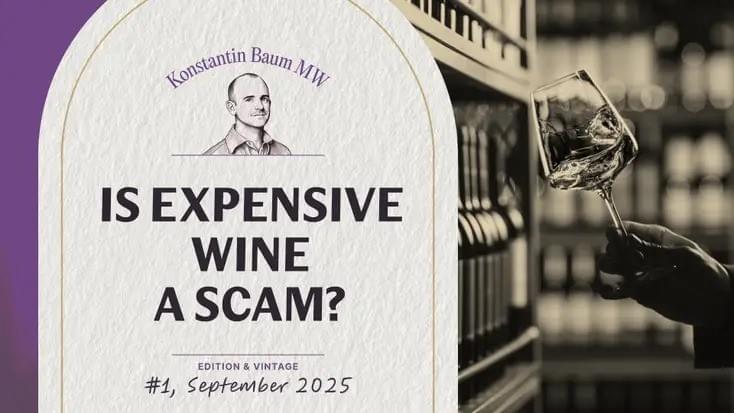
Wine prices have always flirted with the absurd.
At my local shop, I can pick up a solid bottle of Côtes du Rhône for $10. Yet on my shelf sits an empty bottle of Domaine de la Romanée-Conti's Romanée-Conti – a wine that, had I resisted temptation, could fetch $10,000.
Sooner or later, everyone asks the same questions: Can you really taste the difference? And is the price truly justified by what's in the glass, or are we just paying for hype and heritage?
Wine isn't unique in spanning such extremes. You can spend thousands to fly across the world and watch Oasis reunite on stage, or you can stream Liam singing Wonderwall for free on Spotify. The sound might be cleaner, the setting more comfortable but, let's be honest, telling that story at the office on Monday won't carry quite the same weight.
Even the most die-hard wine nerds – and yes, I'm including myself – have to face a humbling truth: at its core, wine is nothing more than fermented grape juice. Grapes are crushed, juice is extracted and, following a protocol that's thousands of years old, wine is made. There are no patents, no trade secrets, no Silicon Valley breakthroughs. The most celebrated winemakers often claim they don’t "make" their wines at all. It's the terroir, they insist. And then they charge twice as much as their neighbors for grapes grown just meters away.
And yet, we don't seem to mind. We happily open our wallets, stroke our egos, and accept that some bottles of fermented grape juice cost a hundred times more than others. But what's really in it for us? Is there a genuine link between price and quality – or is expensive wine just a beautifully packaged illusion?
To answer that, let's turn to global data from Wine-Searcher.
What drives price?
The most expensive wines in the world aren't just pricey – their values are stratospheric. According to Wine-Searcher, Burgundy dominates the charts, which shouldn't surprise anyone who has ever ventured beyond a humble Bourgogne AOC.
At the very top sits Leroy's Musigny Grand Cru at a staggering $48,763 per bottle. Forty-eight thousand, seven hundred and sixty-three dollars! For a single bottle! That's more than the UK's average annual salary.
Close behind is Henri Jayer's Richebourg Grand Cru at $27,771, followed by Domaine d'Auvenay's Bâtard-Montrachet at $25,944. Against those prices, Domaine de la Romanée-Conti's legendary Romanée-Conti Grand Cru almost looks like a bargain at $24,155. Almost. For perspective, that's still more than I earned annually as a young sommelier grinding through 12-hour shifts on the restaurant floor.
So, what drives these astronomical prices? One word: scarcity. Burgundy's Premier and Grand Cru vineyards are tiny – and they can't be expanded. First carved out by monks centuries ago, these patches of land are often no larger than a city block. Add to that inheritance laws under the Napoleonic Code, which splintered vineyard holdings into ever-smaller plots, and scarcity becomes permanent.
Consider this: Musigny covers 10.79 hectares; Bâtard-Montrachet 11.22; Richebourg 7.23; and Romanée-Conti itself? A mere 1.81ha, yielding only about 6000 bottles a year, according to Bourgogne-wines.com. Winemakers further squeeze supply by restricting yields to pursue higher quality, making every bottle even rarer.
That's the supply side. On the demand side, things are equally relentless. Fine wines have transformed into cultural currency – symbols of wealth, sophistication, and pleasure. While global wine consumption is at its lowest in six decades, fine wine continues to sell strongly. Economics 101 tells us that when supply is scarce and demand is high, prices rise until equilibrium is reached. In Burgundy, that equilibrium can soar to absurd levels – especially when demand is fueled by billionaires with bottomless pockets.
Correlation between price and quality
For as long as anyone can remember, the wine world has preached the same gospel: higher price means higher quality. And to a degree, that makes sense. A winemaker turning a healthy profit can invest in better equipment, hire skilled workers to care for vineyards and cellars, and age wines longer before release. Up to a certain point, you really do taste a connection between price and quality.
But eventually, retail prices stop reflecting cost and start reflecting market dynamics – scarcity, reputation, and demand. That's why even seasoned drinkers often struggle to distinguish a $50 wine from a $500 bottle in a blind tasting. Add the price tag, though, and suddenly the same wine brims with "nuance" and "complexity" that went unnoticed just minutes before.
I've fallen into that trap myself. Early on, I often wondered why I didn't "get" certain expensive wines, failing to appreciate their supposed greatness. So I decided to put the question to the test in a YouTube blind tasting. I chose four wines from the same producer, region, and variety, with price as the main variable – from $10 to $500 a bottle. Penfolds of Australia was one of the few wineries offering such a range:
Koonunga Hill Shiraz (~$10): 81 Konstantin Baum points.
Bin 128 Coonawarra Shiraz (~$50): 92 Konstantin Baum points.
St. Henri Shiraz (~$100): 94 Konstantin Baum points.
Grange Shiraz (~$500): 95 Konstantin Baum points.
As expected, the $10 bottle was rough around the edges. The $50 wine was a revelation, jumping 11 points in quality. The $100 wine was more polished, and the $500 Grange edged out the top spot. But here's the kicker: the difference between the Bin 128 and the Grange – a mere three points – cost an extra $450. That's my monthly pain au chocolat allowance for very little gain.
Of course, this was just one Master of Wine's palate. So I turned to Wine-Searcher's database and their Quality-to-Price Ratio (QPR), which compares a wine's score and price to others in its category. A QPR of 10 signals a once-in-a-lifetime bargain; 0.1 is money down the drain. The results backed me up:
- Koonunga Hill Shiraz: QPR 0.03
- Bin 128 Shiraz: QPR 1.69
- St. Henri Shiraz: QPR 1.97
- Grange Bin 95: QPR 0.87
St. Henri quietly offers nearly double the value of Grange – even though Grange is the one flaunted at auctions like a Fabergé egg.
Now, let's return to Burgundy. Henri Jayer's Richebourg Grand Cru sells for $33,000 with a score of 93 points, while Roumier's Musigny Grand Cru scores a dazzling 97 points and sells for "just" $18,000. In a rational world, the higher-scoring wine would cost more. But wine is anything but rational. Jayer's Richebourg clocks in at a microscopic QPR of 0.0024, while Roumier's Musigny manages 0.0295. Both are far from "bargains", but the math is definitive.
The numbers become even clearer in Bordeaux. For decades, a 100-point score from Robert Parker or his successors has been the golden ticket for châteaux. But not all perfect wines are priced alike. Take the 2019 Château Pontet-Canet: a flawless 100-pointer that can still be found for around $130. Not cheap, but a steal compared to its peers. Contrast that with the legendary 1945 Château Mouton Rothschild, also a perfect scorer, now trading around $21,000 a bottle.
The spread is astonishing. A 2010 Château Pape Clément might cost $230, a 2005 Château Pavie $480, and a 2015 Château Cheval Blanc $996 – all 100-point wines, all at wildly different prices. Clearly, brand matters far more than raw quality. Put the same perfect wine in a Cheval Blanc bottle, and it's suddenly worth seven times more than if it were labeled Pontet-Canet.
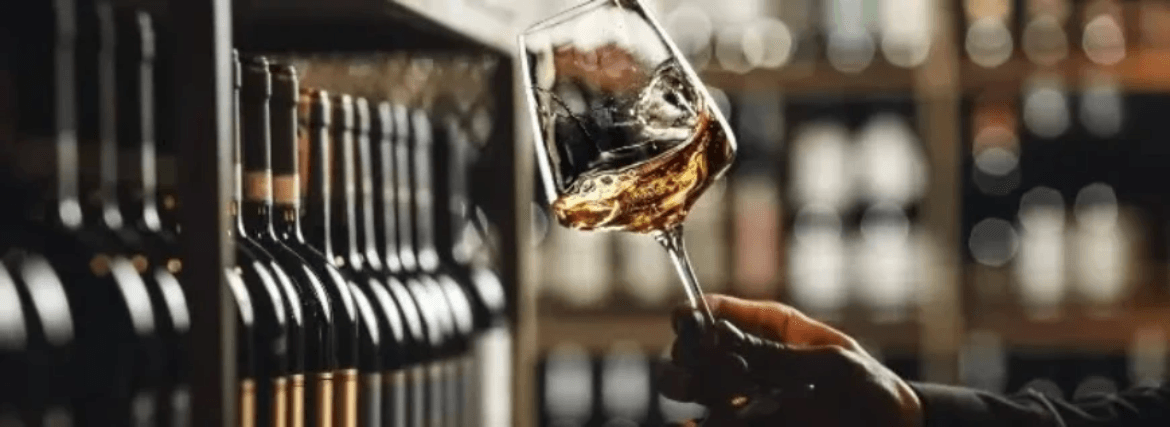
The psychology of wine pricing
If we can so easily access all this data through Wine-Searcher, why do we still reach for that $1000 bottle?
Because your brain isn't a neutral tasting machine. It doesn't crunch Quality-to-Price Ratios like a calculator, spitting out the best deal. Wine is about far more than aromas, tastes, ratings, or prices. We don't just chase the cheapest path to quality – often, the price itself becomes part of the pleasure.
Study after study shows the same thing: we enjoy wine more when we think it's expensive. Pour a simple table wine into a bottle of Screaming Eagle, and suddenly it's described as having "depth, length, and complexity". Serve the exact same liquid from a $20 bottle, and it gets downgraded to "easy, simple, good with barbecue". The wine hasn't changed – only the story has.
One famous 2008 study by scientists at Caltech drove this point home. Participants tasted wines while undergoing MRI scans. Two of the samples were identical wines, but tasters were told that one bottle cost $90 and the other $10. Not only did they report liking the "$90" wine more – their brains lit up with stronger pleasure responses. The perception of value literally rewired the experience.
Price shapes expectation, and expectation shapes enjoyment. That's why storytelling is central to the wine industry. We're not just buying fermented grape juice. We're buying into the 8000-year-old history of Georgian wine, the pioneering legend of Robert Mondavi, the romance of the Tuscan countryside, or the audacious price tag of Liber Pater. Each bottle is more than a drink – it's a mirror, reflecting the kind of person we want to be.
Data-driven wine buying
Are you ready to let go of vanity? Confident enough to trust your own palate? Then let's look at how to find real value by following the data. The bad news: your Instagram posts may not rack up as many likes. The good news: you can drink like royalty without pawning a kidney.
For decades, wine has been sold through numbers. Price came first, and scores soon followed as the marketing tool of choice. But rarely does anyone explore the relationship between the two. That's where the Quality-to-Price Ratio (QPR) comes in. It's your compass in a sea of hype, cutting through inflated reputations and regional prejudice. Think of it as a single number that shows you which bottles deliver the most pleasure per dollar spent.
QPR shines when comparing grape varieties. Take Riesling versus Chardonnay under $30. On Wine-Searcher, the most popular Rieslings average 87.4 points, while Chardonnays sit at 86.2. But the QPR tells the real story: Riesling comes in at 0.34, leaving Chardonnay languishing at 0.089. In plain terms: Riesling offers more joy for less money.
It also works for wine regions. Look at Germany's Mosel, where centuries of winemaking brilliance haven't translated into astronomical prices. The region posts consistently high-QPR values, and wines like Günther Steinmetz's Brauneberger Juffer Riesling Kabinett boast a QPR of 3.5. Compare that to Burgundy, where the 100 most popular Pinot Noirs on Wine-Searcher average an eye-watering $726.43. Yes, they score an impressive 93.6 points, but their collective QPR of 0.46 makes it clear: look elsewhere for value.
That said, QPR is relative, and even in Burgundy there are smart buys. Consider Domaine Faiveley's Corton Clos des Cortons Faiveley Monopole Grand Cru – a genuine Grand Cru priced at $238.86, scoring 93 points with a QPR of 0.8427. Still expensive, but by Burgundy standards a fair deal. Or go even simpler: Louis Jadot's Bourgogne Pinot Noir delivers honest, unpretentious Burgundy at $21.59, scoring 86 points with a QPR of 0.8235.
So whether it's Mosel Riesling, a clever Burgundy pick, or anything in between, QPR helps you drink smarter – and better – without draining your wallet.
Scam or not? An honest answer
So, is expensive wine a scam?
The answer is yes and no. The data shows that quality and price do correlate – but only up to a point. A $10 bottle rarely outperforms a $100 wine, but the leap from $100 to $1000 buys you prestige and scarcity more than sensory delight. Beyond a certain threshold, you're no longer paying for what's in the glass. You're paying for the story, the history, the bragging rights, and the rare chance to drink something most people never will.
Expensive wine is a "scam", just like many other luxury goods, being subject to the same rules as art, watches, or handbags. A Picasso isn't 10 million times "better" than a child's watercolor, but the market values its uniqueness and the cultural meaning attached to it. Wine, at its highest levels, plays in that same arena. Scarcity, reputation, and narrative inflate the price far more than grapes or barrels ever could.
At the same time, the psychology of wine can't be ignored. Expectation shapes experience. If you believe you're drinking something extraordinary, your brain obliges by finding extraordinary flavors. And if you're told it costs $90 rather than $10, it may well taste twice as good. That doesn't make your perception fake – it makes it human. Wine is not consumed in a vacuum. It's wrapped in stories, symbols, and emotions, and those matter just as much as acidity, tannins, or finish.
But here's the encouraging truth: you don't have to play the high-stakes game to drink brilliantly. Looking at the relationship between quality and price we can cut through the fog of reputation and discover wines that deliver outstanding pleasure without decimating our savings accounts, from clever picks in Burgundy, to great Mosel Riesling, and beyond.
Ultimately, expensive wine is a scam, but it is not the only path to great drinking. It occupies a cultural space where scarcity and symbolism matter as much as flavor. If you're wealthy enough to collect Romanée-Conti, enjoy it – just know you're buying a story as much as a wine. If you're like most of us, use the data to your advantage. Let QPR guide you toward hidden gems and take pride in outsmarting the market rather than being seduced by it.
Because at the end of the day, wine is meant to be enjoyed, not just displayed. Whether your glass holds a $20 Riesling or a $2000 Grand Cru, the true measure of value isn't the price tag or even the points – it's the pleasure in the glass.And yes, sometimes I enjoy being "scammed" by the allure of a famous label. But most of the time, I find greater joy in looking past the hype and discovering wines that deliver genuine quality at the right price.
